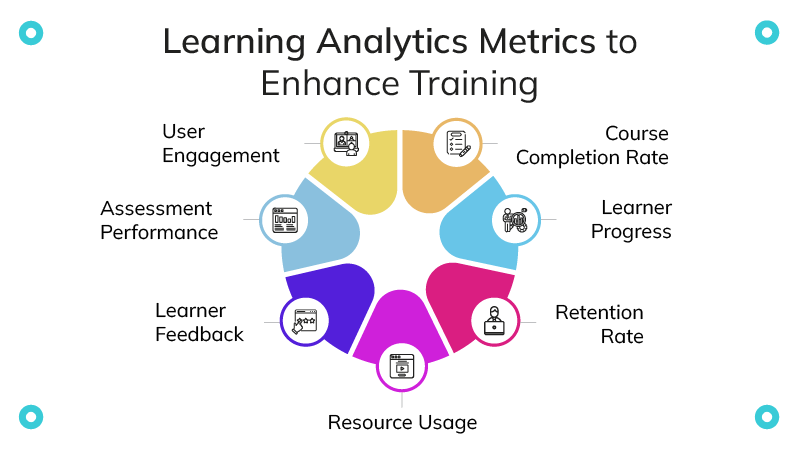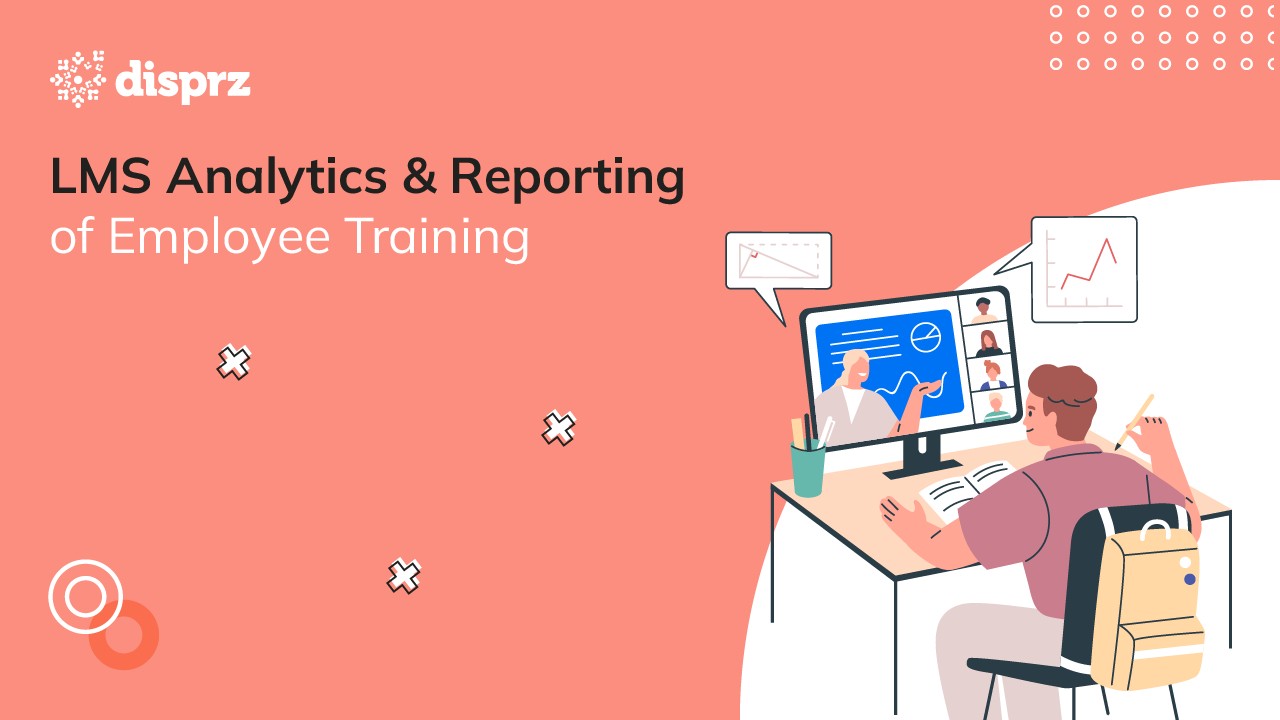Introduction to Learning Analytics in LMS
In the digital age, learning management systems (LMS) have seamlessly integrated into corporate training settings, streamlining course content delivery and assessment processes while generating valuable data. This data is instrumental in unlocking insights that enhance the learning experience and refine instructional strategies, highlighting the importance of LMS analytics.
Delving into the realm of LMS analytics is essential for gauging learning program success, albeit challenging. Effective analysis entails tracking and interpreting relevant data, and translating it into insightful reports to demonstrate return on investment (ROI). Focusing on critical data points, such as learner progress, engagement, and feedback metrics, is crucial for assessing program impact and optimizing outcomes.
Types of Learning Analytics in LMS
Effective learning depends on accessing relevant information. By asking the right questions, you unlock insights from various types of learning analytics, each offering unique perspectives and valuable lessons.

Descriptive analytics
Descriptive analytics provide a basic overview, revealing what occurred without further insight. They help identify patterns and trends, such as understanding course completion rates by revealing the percentage of learners who finished a course.
Diagnostic analytics
Diagnostic analytics delve into the reasons behind observed trends or events, providing insight into the cause-and-effect process, which helps in understanding the root causes of issues within the learning program.
Predictive analytics
Predictive analysis utilizes algorithms and statistical models to forecast future outcomes based on existing data, leveraging historical patterns to anticipate trends. Although predictions aren't infallible, examining past trends can provide valuable insights into future probabilities, like predicting a consistent course completion rate if no changes are made.
Prescriptive analytics
Prescriptive analytics offer recommendations for enhancing learner outcomes and increasing course completion rates by suggesting specific actions. By analyzing data trends, prescriptive analytics identify opportunities for improvement, such as reducing module size, enhancing context, or implementing early interventions to support learners' progress.
Benefits of LMS Analytics for Employee Training
LMS analytics yield numerous benefits for both learners and employers, leveraging data to
Personalized learning
Leveraging LMS analytics, trainers gain deep insights into each learner’s progress, strengths, and areas needing improvement, facilitating tailored learning experiences through customized recommendations and interventions.
Identify at-risk learners
Utilizing data analysis, LMS analytics can highlight learners facing challenges or potential disengagement, allowing trainers to intervene early, offer vital support, and ultimately boost learner retention rates.
Measure learning outcomes
Provide accurate and timely insights into learning interventions' effectiveness, allowing trainers to identify successful instructional strategies and make data-driven decisions for future course development based on learning outcomes assessment.
Enhance instructional design
By examining data derived from the LMS, trainers gain valuable insights into learners' interactions with course content, enabling them to refine instructional design and develop more engaging, interactive, and impactful learning materials.
Track progress and performance
With LMS analytics, trainers can monitor learner progress and performance in real time, effortlessly tracking completion rates, grades, and participation levels to identify trends and adjust training methodologies accordingly.
Key Reporting & Analytics Features in LMS
-
Learning data analysis and LMS reporting offer actionable insights into L&D processes.
-
Improving course content enhances the learner experience.
-
Real-time analytics enable continuous improvements with immediate feedback.
-
Predictive analytics based on historical learner activity aid in creating better learning content.
-
In-depth analytics help optimize learning paths for quicker competency attainment.
-
Insights on resource allocation ensure focus on high ROI initiatives.
-
Personalized user experiences through individualized dashboards cater to diverse learning styles.
-
Leveraging data on learner competency ensures compliance with mandates.
-
The right LMS platform facilitates rapid improvement of eLearning courses for optimal results.
7 Key LMS Analytics Metrics To Enhance Employee Training

Here are the 7 essential learning metrics to analyze in 2025 for significantly enhancing your employee training programs:
1. User engagement
2. Course completion rate
3. Assessment performance
4. Learner progress
5. Learner feedback
6. Retention rate
7. Resource usage
1) User Engagement
Measuring user/employee engagement metrics gauges learner involvement within the LMS, covering login frequency, platform duration, and course interaction. Analyzing this data helps identify learners requiring support and assesses platform effectiveness. Reporting on user engagement is essential for optimizing learning experiences and outcomes.
2) Course Completion Rate
The completion rate metric quantifies the proportion of learners who successfully finish a course, indicating its effectiveness and appeal. Analyzing completion rates highlights areas for improvement and provides insights into learner motivation and satisfaction, guiding content refinement.
3) Assessment Performance
Assessment performance metrics, including average scores and grade distribution, offer insights into learner comprehension and knowledge retention, aiding in pinpointing areas for additional support and course content refinement through analysis.
4) Learner Progress
Monitoring learner progress metrics, which include completed modules, accessed lessons, and achieved milestones, provides a comprehensive overview of learner advancement, facilitating timely interventions and support by identifying potential bottlenecks or challenging areas through reporting.
5) Learner Feedback
Gathering feedback from learners via surveys, ratings, or comments is invaluable for assessing contentment and pinpointing areas needing improvement. Reporting on learner feedback informs decisions on course content and instructional design, enhancing overall learning experiences.
6) Retention Rate
The retention rate measures the percentage of learners who maintain engagement with the course or program over time, aiding in identifying potential dropout issues. Reporting on retention rates enables targeted interventions and support to enhance learner retention by addressing underlying challenges.
7) Resource Usage
Monitoring resource usage metrics provides insights into the effectiveness and popularity of various learning materials, including videos, documents, and interactive modules. Reporting on resource usage refines content creation and delivery, ensuring learners have access to relevant and engaging materials for effective learning.
How To Use LMS Analytics For Better Personalization
Utilizing LMS analytics for enhanced personalization involves several steps
Collect Comprehensive Data
Gather data on learner behaviors, preferences, and performance within the LMS, including completion rates, assessment scores, time spent on modules, and content interactions.
Segmentation
Segment learners based on factors such as skill level, learning pace, preferred learning styles, and knowledge gaps identified through analytics.
Customized Content Delivery
Deliver personalized learning experiences by offering customized learning paths, recommended resources, and adaptive content based on each learner's profile and progress.
Adaptive Learning Paths
Use analytics to dynamically adjust adaptive learning paths in real time, directing learners to appropriate content and activities based on their performance and objectives.
Feedback Analysis
Analyze learner feedback and engagement metrics to understand preferences and areas of interest, informing further personalization efforts.
Continuous Optimization
Continuously analyze LMS analytics to refine personalization strategies, ensuring that learners receive relevant and engaging experiences that meet their evolving needs and preferences.
Conclusion
Harnessing LMS analytics empowers organizations to make data-driven decisions, optimizing learning programs for both learners and organizational goals. With Disprz, take the first step towards personalized and impactful training experiences.
Book a demo now to unlock the full potential of your learning initiatives. Experience the transformative power of advanced analytics, seamless integration, and intuitive user interface, ensuring maximum engagement and effectiveness in every training endeavor.








